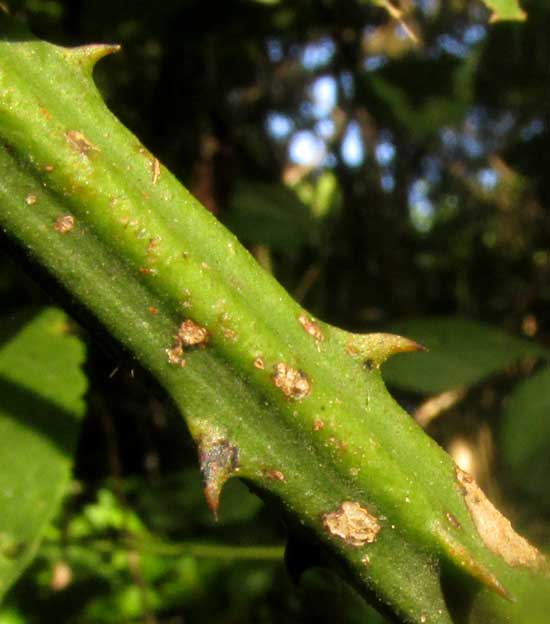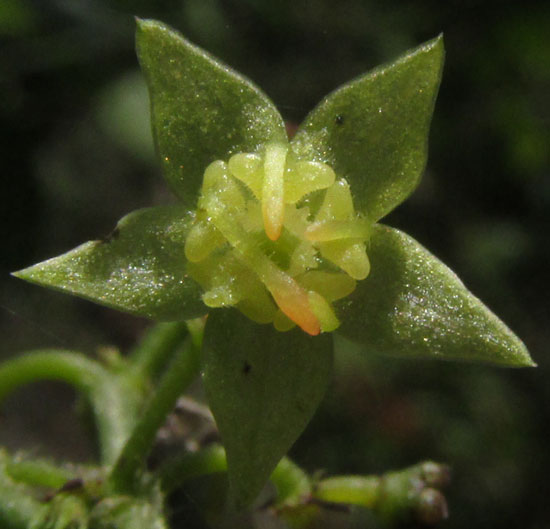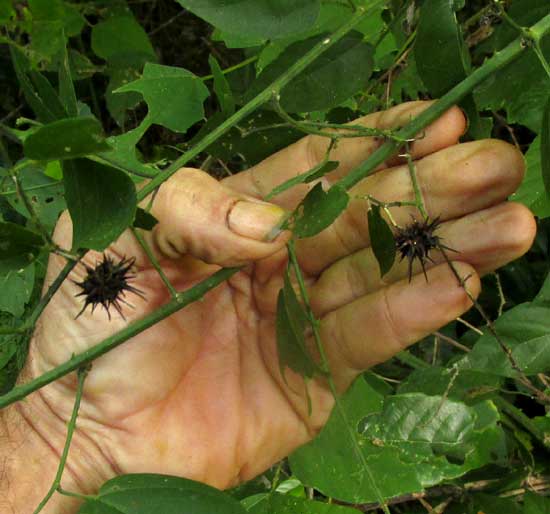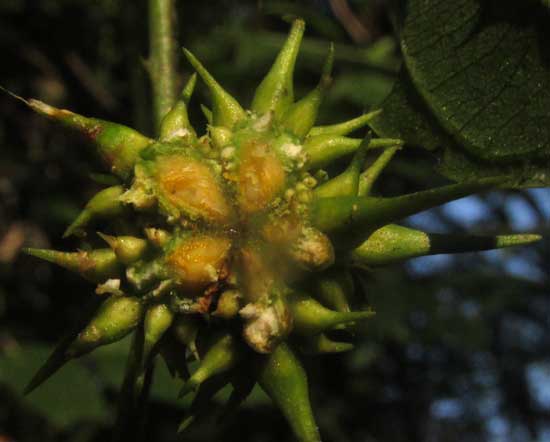Excerpts from Jim Conrad's
Naturalist Newsletter
from the December 17, 2017 Newsletter issued from Rancho Regenesis in the woods ±4kms west of Ek Balam Ruins; elevation ~40m (~130 ft), N20.876°, W88.170°; north-central Yucatán, MÉXICO
AYENIA ACULEATA
Below you can see a spiny bush stem that left my arm bleeding when I brushed by it:

That looks like a blackberry stem up north, and the leaves were vaguely like those of a blackberry's leaflets, as shown below:

And some stems of that several-stemmed, 9-ft-spreading (3m) bush bore soccer-ball-size flowering clusters somewhat like a blackberry bush's inflorescences. However, the 5mm-broad (1/5th inch) flowers were nothing like blackberry flowers, as you can see below:

It was a very unusual flower, and its parts were hard to interpret. Seeing this, instantly I knew that here I needed to "do the botany," and that it would be a challenge. Hot dog!
First of all, are those five green items making the flower star-like corolla lobes or a calyx's sepals? The rear view of the above flower answered the question, seen below:

There's nothing between the star-like green parts and the flower's stem, or pedicel, so the green items are forming a calyx. In the above flower picture, the stamens must be those matchstick-like items with an orange blush where the anthers must be. Below, a side view of the blossom shows the stamens with very kinky filaments:

And now a closer look at the flower head-on is seen below:

What are the waxy-looking, pale, round-pointed items at the stamens' bases? My first impression had been that they were modified, sterile stamens known as staminodia, but usually staminodia occur between stamens, and they could well be growing from the stamens' filaments. And I'm guessing that the short, whitish, crown-like feature at the stamen's bases are much reduced flower petals. Finally, I see no hint of an ovary, so this must be a unisexual male flower.
This was all last June. As the months passed I kept trying to figure out at least which family the plant belonged to, but with no luck. The various "Key to the Plant Families" I knew of never helped, apparently because I was misinterpreting one or more flower parts. I found the species rarely and spottily occurring here.
Finally, about a month ago a few fruits appeared on the bush's branches, and they were nothing like I'd anticipated. You can see them below:

A fruit close-up is shown below:

Is this a single spiny fruit, or clusters of fruits with pointy tops? Cutting across a spiky thing's equator, I found what's shown below:

So, each sea-urchin-like this is an individual fruit. The above photo shows that the fruit consists of five compartments, or carpels, each containing at least one hard, bony seed.
But, even with this new information, I couldn't identify the bush. In the end, this week I discovered the plant's identity by accident, finding it as I worked on another species.
It's BYTTNERIA ACULEATA*, with no proper English name. Traditionally the species has been assigned to the nearly entirely tropical Chocolate or Sterculia Family, the Sterculiaceae, but modern genetic analysis has caused that family to be merged with the much larger, more generally occurring Hibiscus Family, the Malvaceae.
Even knowing this, it's hard to interpret some of the flower's features. Page 406 of Standley and Steyermark's Flora of Guatemala in the December 27, 1949 edition of Fieldiana:Botany, Vol 24, Part VI, published by the Chicago Natural History Museum, speaks of the species' flowers as having "lobes of the stamen tube alternate with the petals, the anthers solitary in the sinuses." No mention is made of flowers being unisexual. If I'm understanding the description right, then the waxy-looking, rounded items at the base of the stamens are part of the "stamen tube," the stamen tube being a cylinder formed by the stamens' fused filaments, and such stamen tubes are a prime field mark for members of the Hibiscus Family.
But, I've never seen a stamen tube even slightly resembling what's shown in our pictures.
Byttneria aculeata is native to most of Mexico south through Central America to northern South America, plus it's spreading as an invasive in certain tropical countries. Standley and Steyermark describe the species as one of the worst weeds in Guatemalan banana plantations, soon forming impenetrable thickets. Also, "Wherever it grows, the shrub is a great pest, since the sharp prickles tear the flesh painfully, so that it is impossible to pass through an infested place without the use of a machete."
In the Yucatan, the Maya traditionally use the species to cure skin problems, venereal diseases, and diarrhea.